Expert Guide to Buying an Inverter

An inverter is a device that converts direct current (DC) into alternating current (AC). In terms of camping and caravanning, this generally means something that will convert the electricity from a 12 volt (V) leisure battery to a form that will run domestic electrical equipment designed to work from a three-pin 230V socket within the capability of your system. This Expert Guide will explain what they are used for, the different types available as well as providing advice on buying the right size for your needs and what is needed to power them.
At its simplest, an inverter could be a DC motor driving an AC generator although such a device is more commonly referred to as a rotary converter. The inverters here all use electronics to achieve the desired result. This eliminates any moving parts while improving both efficiency and reliability.
Uses of inverters
Within the field of electrical engineering inverters have a vast number of application's. An increasingly common one is connecting solar panels to the normal AC power grid. They may also be found in some wind turbines where they enable the production of steady AC power regardless of the speed of the wind.
In this Expert Guide, we focus on small inverters as these are the most useful to those camping in tents, caravans, campervans and and motorhomes. Typically these are in the range 100 watts (W) ideal for low powered items like phone chargers and laptops to 3,000W for a kettle of heater although this high output would drain the typical battery set-up in minutes, we will come on to this later.
How inverters work
Inverters work by taking DC power and switching it on and off through a transformer. This produces an alternating current (AC) waveform on the output side of the transformer. The ratio of the windings is such that the output is at 230V. The earliest inverters used a mechanical vibrator to do the switching, though modern types use electronics.
How do I choose an inverter?
There are two principal types of inverter output – modified sine wave and pure sine wave. The former may also be referred to as quasi sine wave. These definitions refer to the AC output waveform of the inverter. It is important to choose carefully before you part with your money.
Modified sine wave inverters
The mains supply from the utility companies should be a pure sine wave with the voltage rising and falling in a steady rhythmic pattern. This is what most appliances are designed to use to work efficiently.
Reproducing such a waveform from a steady DC input voltage is not easy or cheap. However, producing something that resembles it is. This is what modified sine wave inverters do.
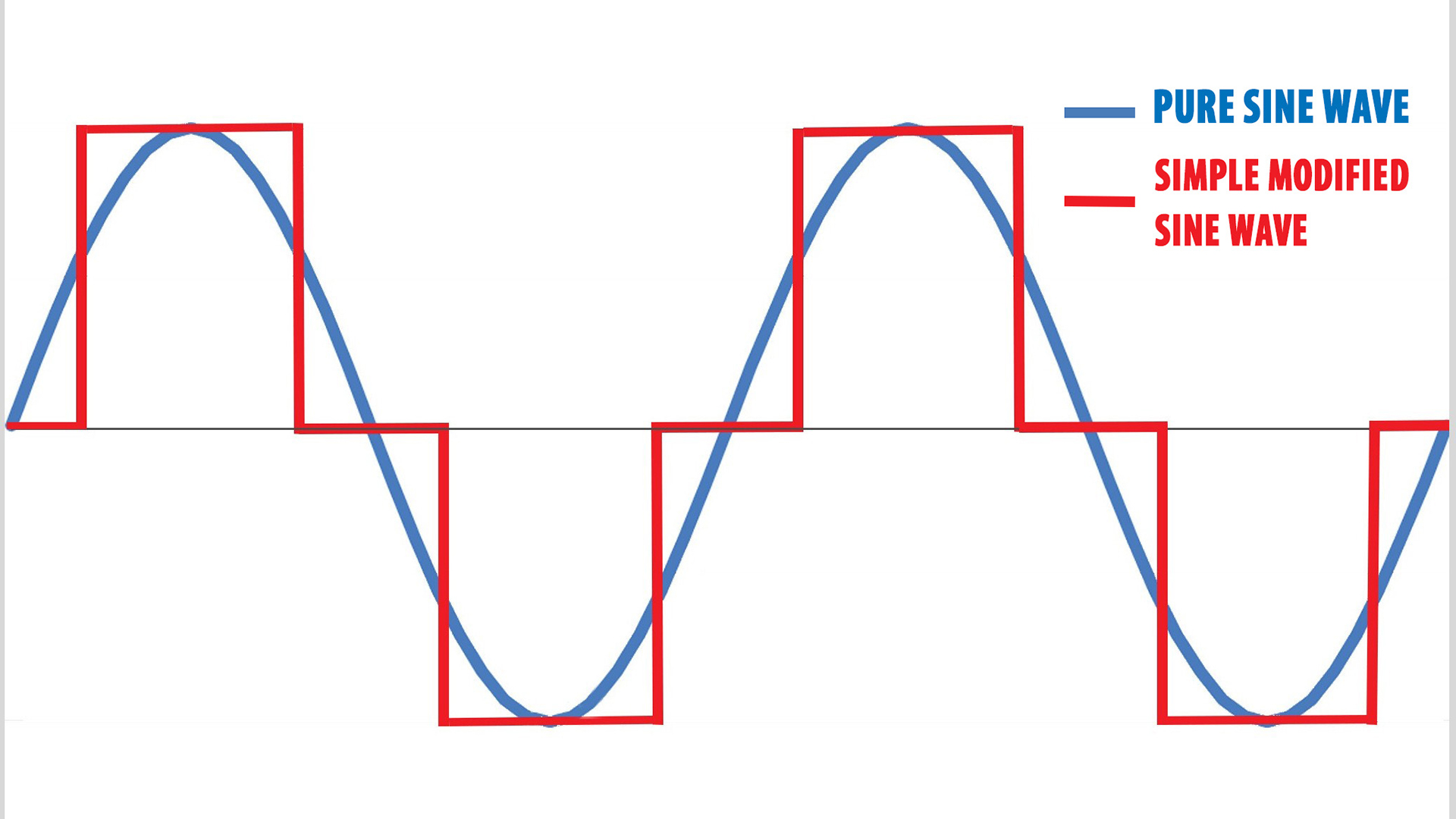
The graph above shows one of the simplest forms of modified sine wave. The very sharp increases and decreases in voltage can cause problems with some applications, such as interference on a TV picture, a hum on sound equipment or even overheating of transformers and chargers for gadgets.
To mitigate these problems you can pay a bit more for an inverter with more steps in the waveform. The graph below shows a two-step waveform and you can see how much more closely the output matches that of the sine wave. Even so there are still sharp edges that may cause problems with some equipment.
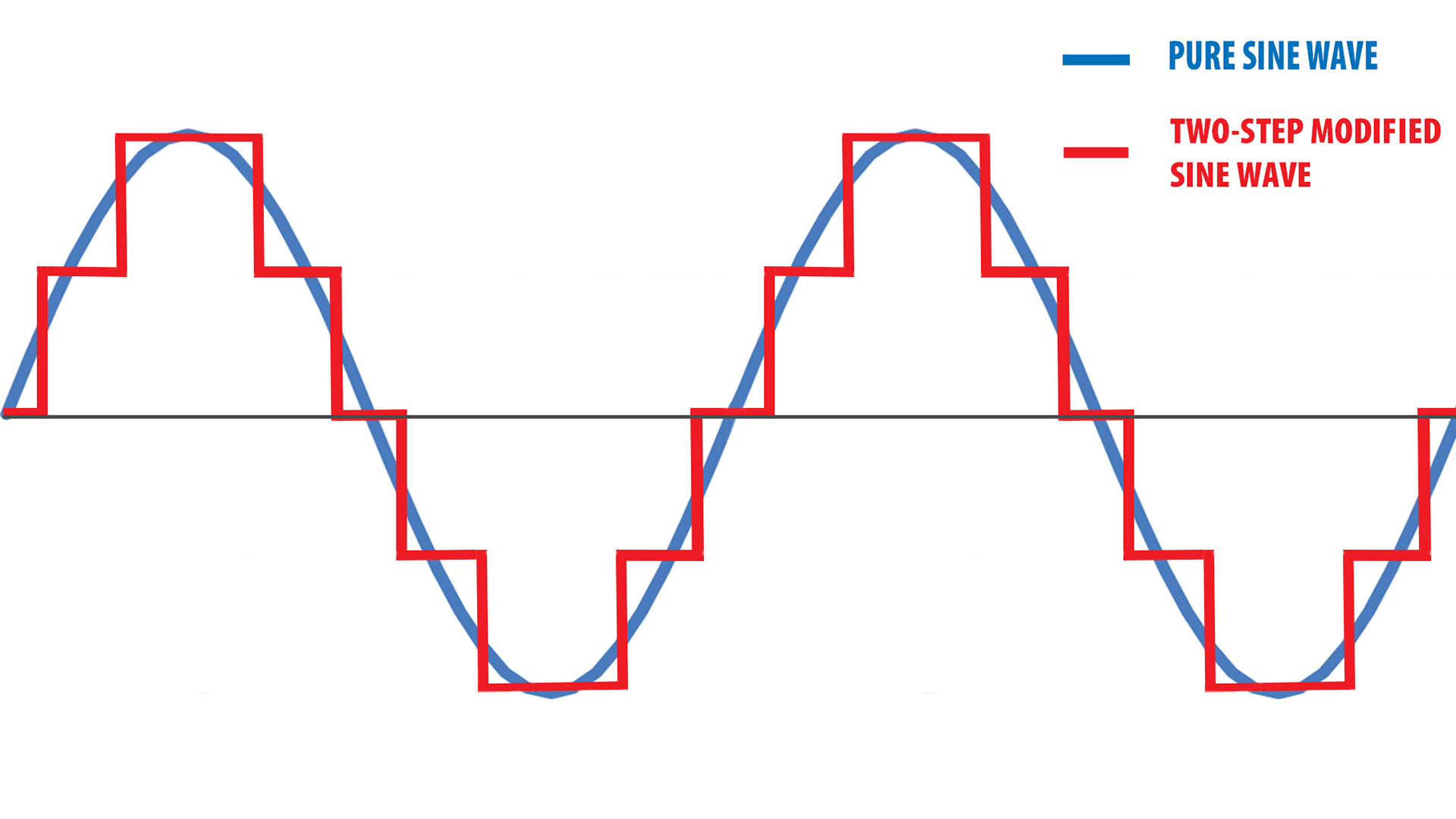
You may find inverters with even more steps in the waveform but if you really need that degree of refinement you may be best opting for a pure sine wave inverter. In a well-designed modified sine wave inverter, the area between the red line shown here and the base line in the middle should be similar to the area enclosed by the curve of the pure sine wave. This area is a measure of the potential power available to drive the load.
 A modified Sine wave inverter will be OK for non sensitive product
A modified Sine wave inverter will be OK for non sensitive product
Uses
Modified sine wave inverters can successfully power a wide range of equipment. Examples include power drills, blenders, hairdryers, curling tongs, simple battery chargers and so on, though in a camping environment most of these will drain a 12V leisure battery very quickly.
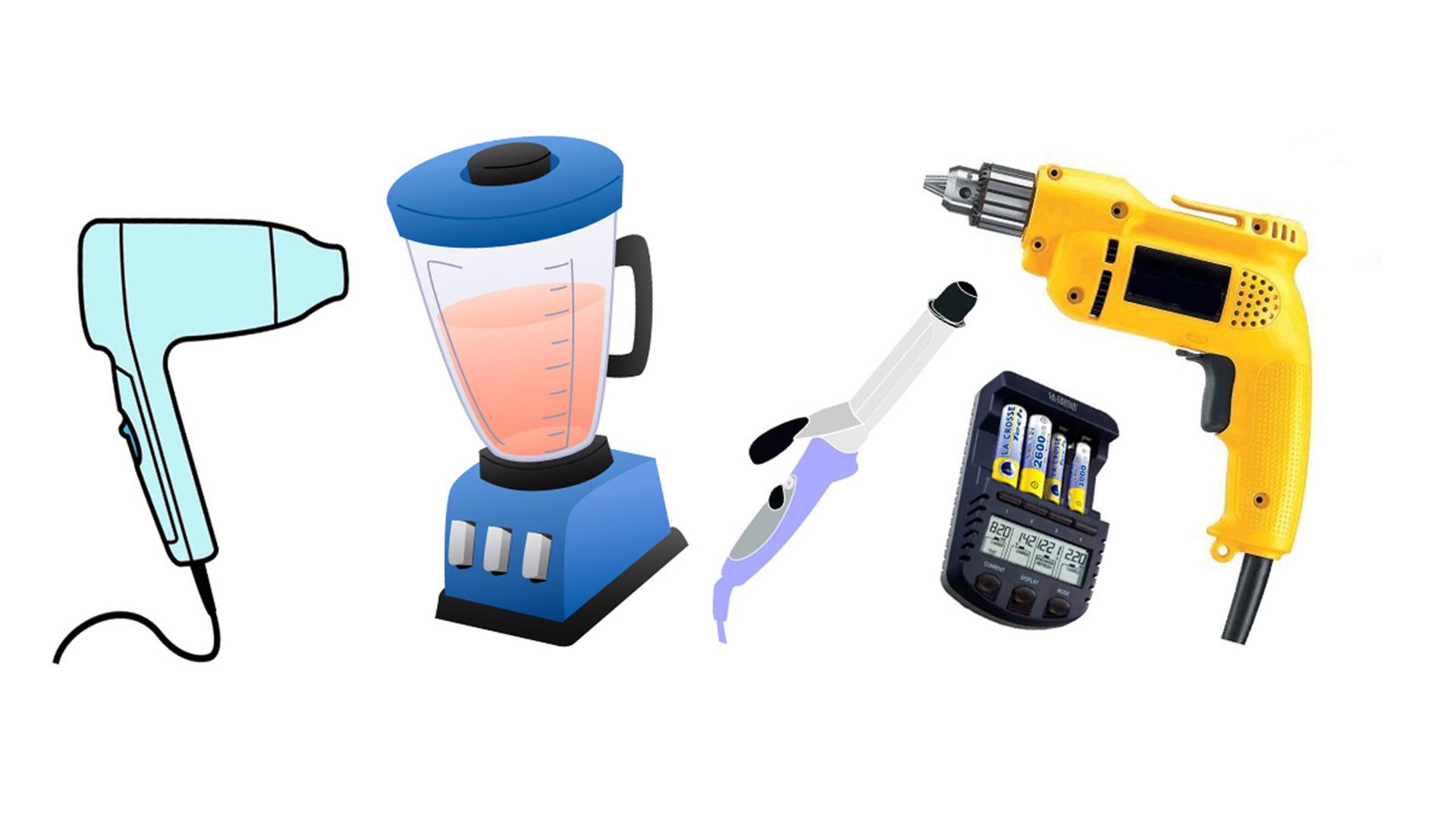 Typical appliances that can use a modified sine wave inverter
Typical appliances that can use a modified sine wave inverterMany computers will tolerate a modified sine wave but it is always best to check with the manufacturer first. However, if you are running a laptop using a charger with its own power adaptor, the worst that is likely to happen is that it will be damaged. The laptop itself should be fine. Where you do have to be careful is with sensitive electronic loads. For these, a pure sine wave inverter is essential.
If interference becomes a problem it can sometimes be mitigated by moving power leads around or even fitting a ferrite filter bead to a power lead of the appliance.
The pros and cons of modified sine wave inverters can be summed up as follows:
Pros
• Relatively cheap
• Can be used with a fairly wide range of equipment
Cons
• May cause interference
• May damage sensitive equipment
• May cause overheating
Pure sine wave inverters
Pure sine wave inverters reproduce exactly the waveform generated by the utility companies and can therefore safely be used with any type of load.
Uses
Essential for sensitive kit such as electric tooth brushes, Continuous Positive Airway Pressure (CPAP) machines (a positive airway pressure ventilator, used to correct sleep apnoea for example), and switch mode chargers such as may be used with cordless power tools. However, if a piece of medical equipment (such as a CPAP machine) is vital it is recommended you do not rely on an inverter alone. A generator or other constant electricity supply, such as a campsite electric hook-up, is preferable.
Pros
• Suitable for all equipment (subject to load requirements)
Cons
• Expensive (but getting cheaper)
If you are put off by the cost of a pure sine wave inverter you could consider buying a small one for sensitive items and a larger modified sine wave inverter for everything else.
Alternative means of supplying electrical power
Some devices only require a low voltage so use a suitable transformer to reduce and convert mains electricity to allow this. Therefore, many of these devices could then be powered from the 12v DC outlets via an approved adaptor, so check with the equipment supplier whether an adaptor is available. For example some camping TV's, tablets and mobile phones have suitable adaptors widely available so reducing the need for an inverter and the efficiencies losses covered below.
Inverter efficiencies
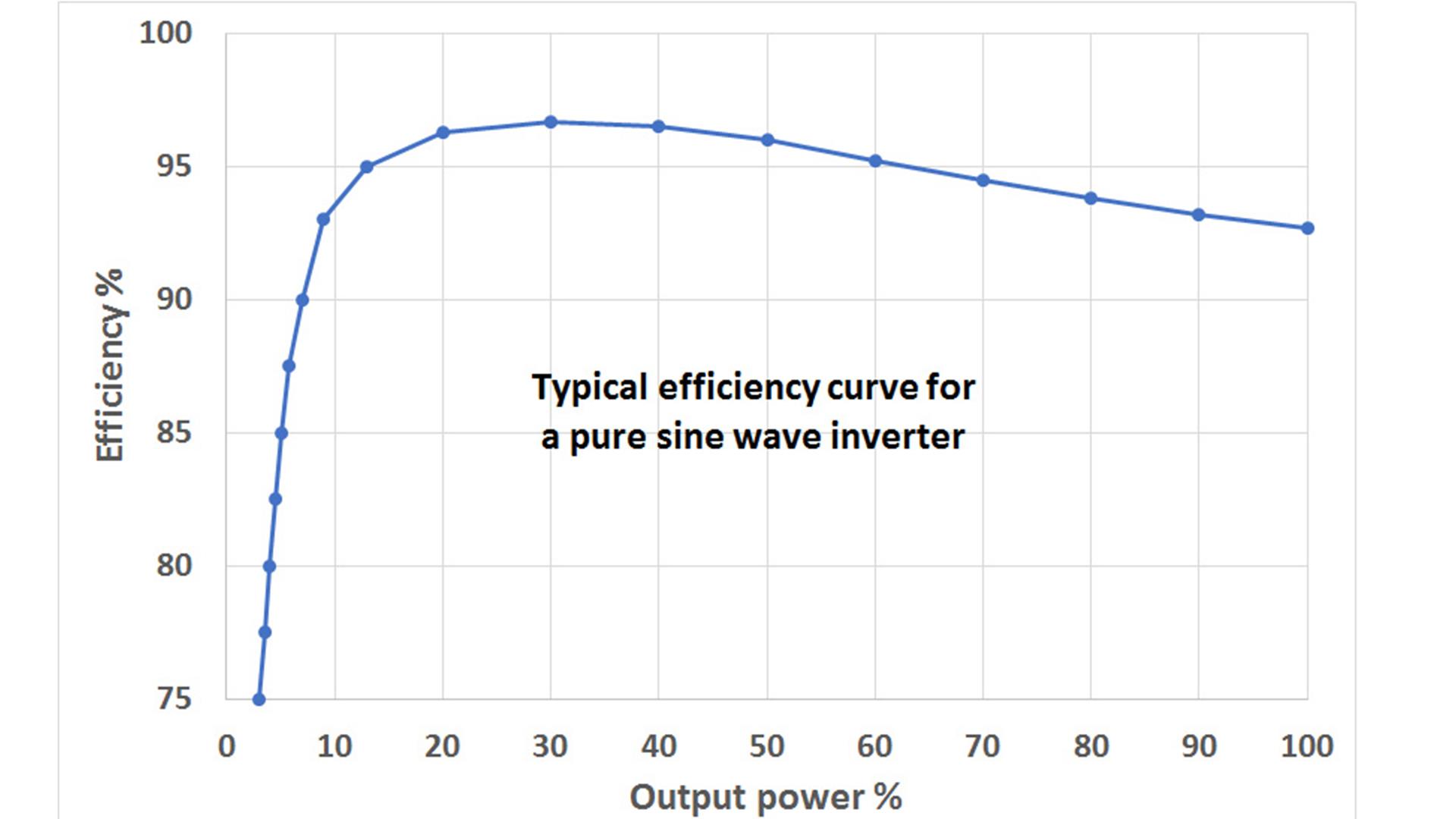
Good quality sine wave inverters can achieve efficiencies of 90-95 per cent in terms of output power to input power. Cheaper modified sine wave variants may be in the range 75-85 per cent. The power loss takes the form of heat generated during conversion and also when in standby.
Efficiency is important factor as a poor system would eat in to the battery capacity or the system would need to be oversized to compensate for the losses. Inverters are at their most efficient at between about 15 and 60 per cent of rated output power. Below 15 per cent the efficiency can drop off quite rapidly, so do not get an inverter that is much bigger than you really need.
What size of inverter do I need?
Once you have decided on the best type of inverter for your needs the next consideration is what power rating you will need and where that power is going to come from. First you need to consider the wattages of the devices you intend to run, deciding which of them you might want to run simultaneously.
 Make sure your usage demands will be met by the inverter
Make sure your usage demands will be met by the inverterIn the example shown here we have three items totalling 610W that may typically be used at the same time during a caravan or motorhome break – hair straighteners, a low power kettle and a laptop computer. In this case, an inverter of 750 or 1,000W would be a good choice, giving a little extra headroom for the future.
 Some smaller inverters are designed to go in your vehicle drinks holder and plug into 12v sockets
Some smaller inverters are designed to go in your vehicle drinks holder and plug into 12v sockets
Can-type inverts fit into vehicle drink holders and draw power from the 12v sockets. With up to 200W of AC power at 230V they are designed to run laptop computers, video game consoles and various other electronic devices. Most also feature a USB charging socket.
When powered from leisure batteries, inverters are normally at their best when supplying smaller loads such as the laptop and hair straighteners in our example. However, in a motorhome, extra power may be available along with good charging facilities. In this sort of environment inverters have much more scope.
If you want to run a hairdryer, you will need an inverter of at least 1,500W, but taking that amount of power from a standard leisure battery will flatten it in just a few minutes.
 To make the most of an inverter connect to the battery being charged by the vehicle alternator
To make the most of an inverter connect to the battery being charged by the vehicle alternator
A powerful alternator coupled with a lithium battery can power microwave ovens, vacuum cleaners, hairdryers and so on, while the battery itself has a fast recharge rate. While such set ups are expensive, they do point the way forward for mobile power while camping.
 This EZA unit looks after the 80ah battery and 1500w inverter, note the cable sizing
This EZA unit looks after the 80ah battery and 1500w inverter, note the cable sizing
There are units with built-in inverter and lithium battery that can make installation more convenient. Designed for use with a motorhome, the sockets on the left accept a variety of charging sources including the vehicle’s alternator (direct connection) and solar.
We recommend these larger inverter are professionally installed to ensure it is safely integrated with your existing systems.
Power ratings and what they mean
Inverters may be rated according to their peak power or to their average power. The first is the maximum power that can be provided for an instant. Any longer would result in damage or automatic shutdown. The second is the power that can be provided on a constant basis, without time limits. Peak power is normally around twice average power so it does pay to read the label carefully. Peak power is useful to know when sizing an inverter for loads with a high starting current (see below).
Inverter sizing guide for appliances and gadgets
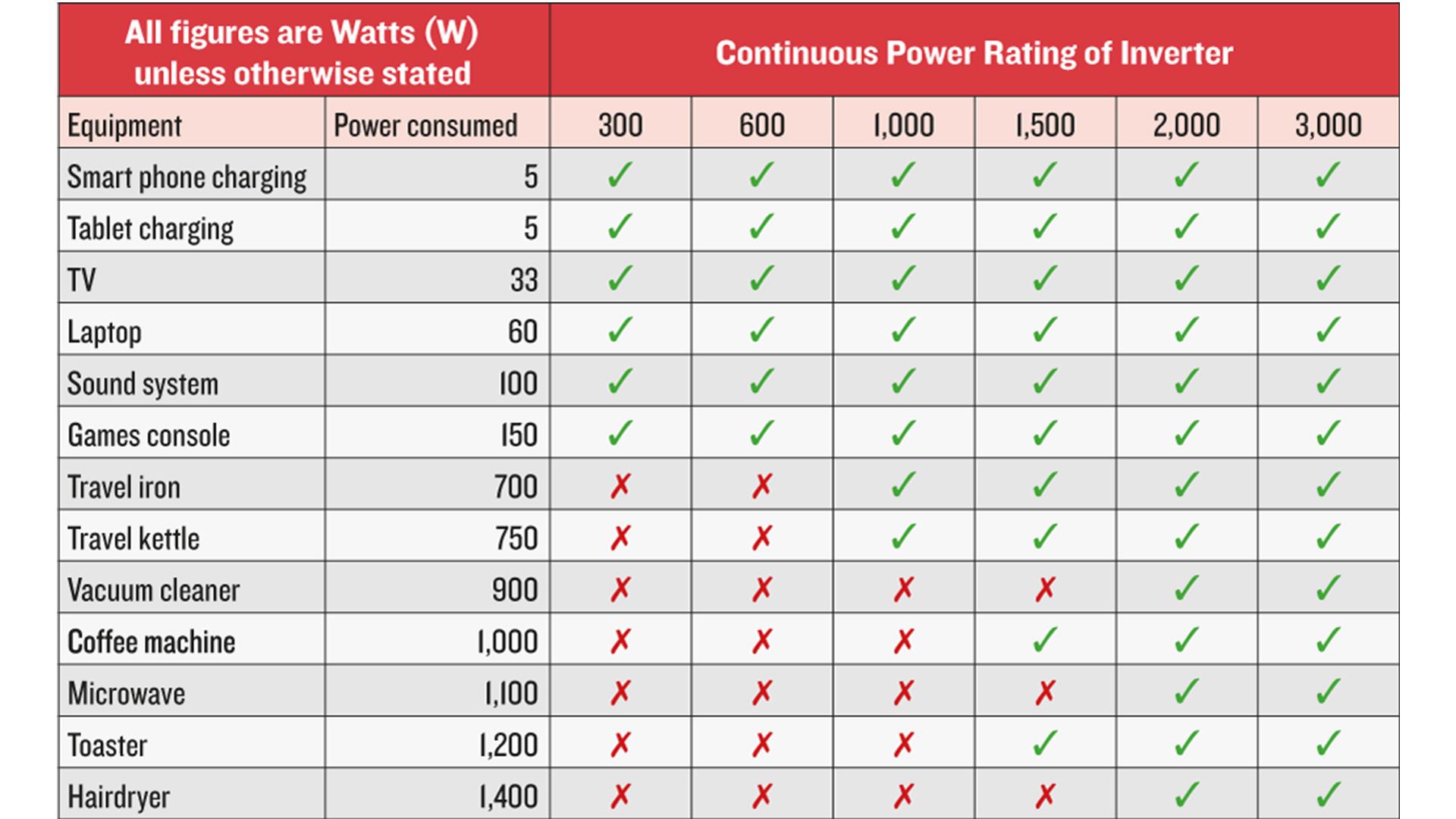
Starting loads
Some equipment requires a high starting current. Items such as power drills and compressor fridges have a motor that needs more power to get it moving initially. This can be up to six times the normal running current and needs to be factored in when specifying the inverter.
Microwave ovens
Microwave ovens are fitted in plenty of modern caravans and motorhomes and present a particularly difficult load for power inverters.
First, the ovens have a high starting current. Also, when the oven is run at less than full power, it is often automatically switched on and off at regular intervals to lower the average power. Each switch on has its own surge and these can be especially demanding for an inverter.
Secondly there is the power rating of the oven itself. A 600W oven puts 600W of energy into the food but, in so doing, may take 1,000W or more from its 230V supply.
Our recommendation is to choose an inverter with a continuous power rating of at least twice the cooking power of the oven.

Batteries and connections
The type of battery that powers an inverter, and the connections and cable sizes used, play a big part in ensuring it works to its full capacity.
Best types of battery to use
Inverters can use a lot of DC current over a period of time. The best type of battery for an inverter to draw power from is therefore a deep cycle one. Lead acid types are designed to be repeatedly discharged down to about 50 per cent of their nominal capacity before being recharged. AGM (absorbed glass mat) versions are well suited to use with inverters because of their low internal resistance (which aids the flow of current) and an improved deep cycle ability when compared with standard lead acid types.

If you can stretch your budget to a lithium battery, do so. Lithium batteries can be repeatedly discharged down to about 20 per cent of capacity and can be recharged very rapidly, this is particularly beneficial in motorhomes and campervans where the alternator can be utilised.

Batteries are a product where you generally get what you pay for so avoid budget models and buy one with a good name and guarantee. See our Guide to Leisure batteries here for more information.
Using more than one battery
In order to make more power available you may wish to employ more than one battery. For a seamless flow of electricity, you can connect batteries together. For this to work efficiently the batteries should be as near identical as possible in all respects – size, age, previous usage and so on. See the two diagrams below.
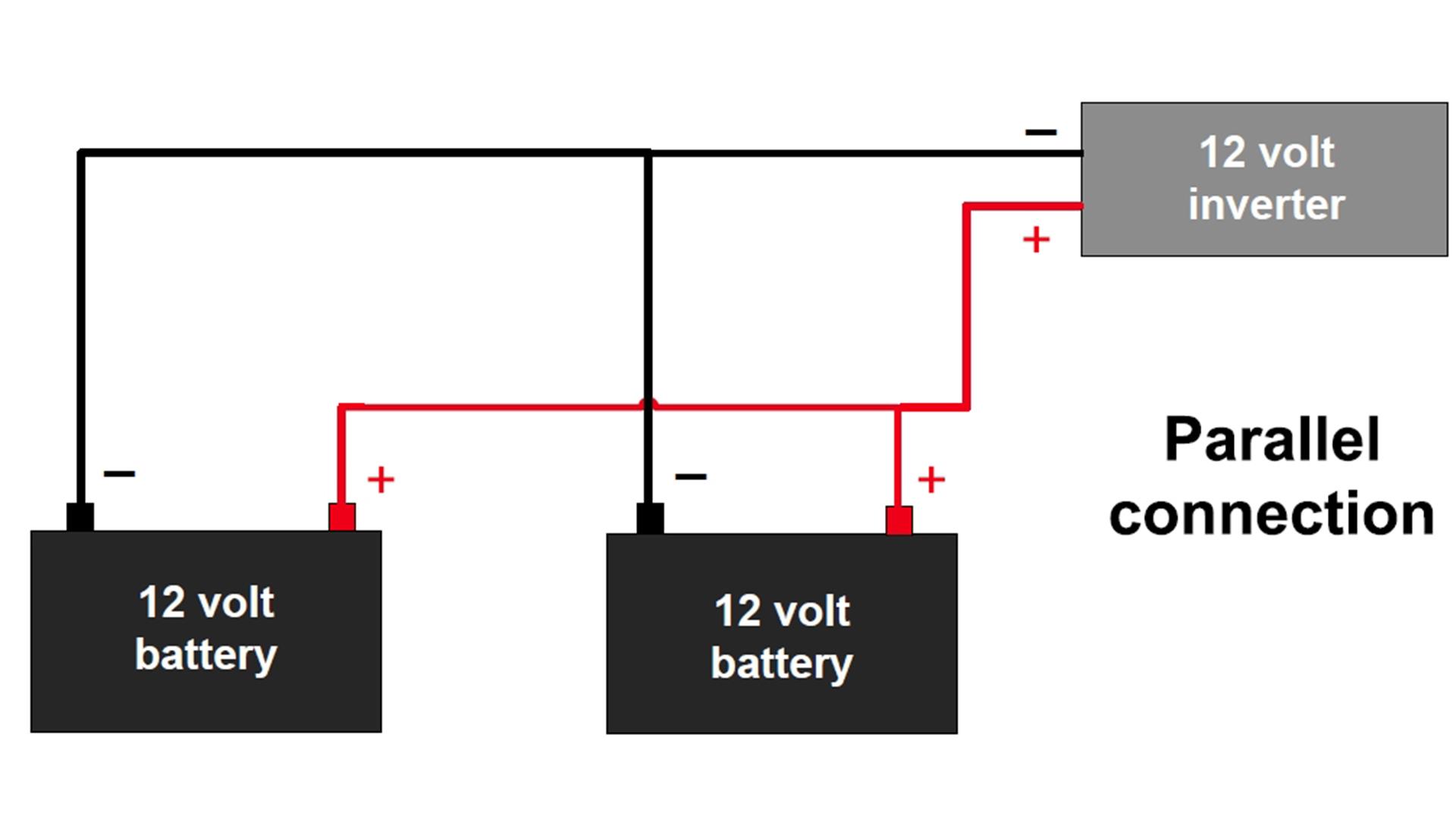
Connecting batteries in parallel (positive to positive, negative to negative) maintains the voltage at 12V while connecting in series (positive to negative) will almost double it to 24V. This latter option only makes sense if you have a 24V inverter.
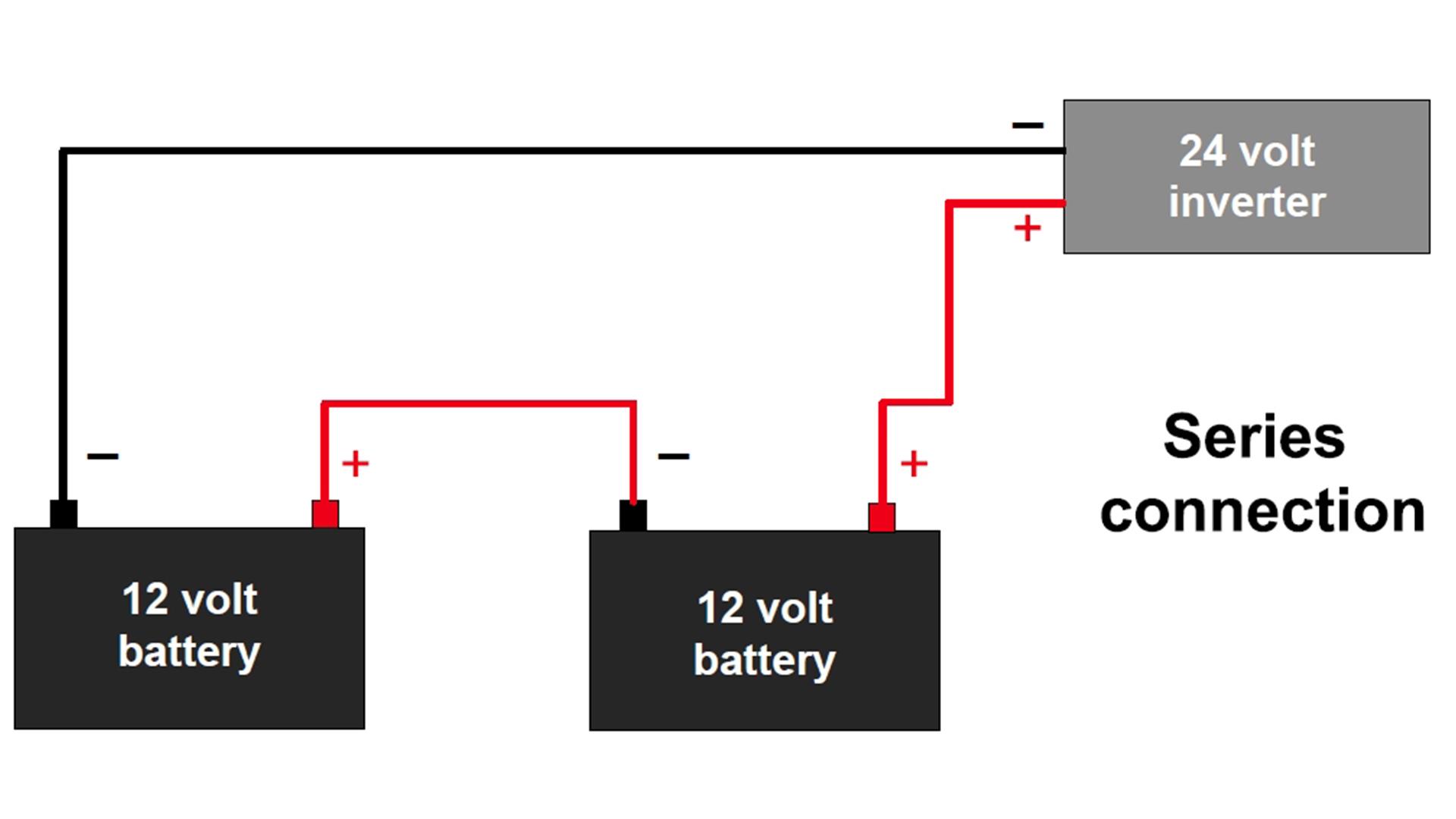
If you are thinking about additional batteries to supply your inverter needs do consider one good quality lithium instead. They have around twice the capacity for half the weight and in the case of a motorhome or campervan can be charged very rapidly from the alternator if correctly installed.
Connecting to a battery
The DC current needed by inverters varies from about 5A to 150A or more. These sorts of currents require good, low resistance connections and suitably sized cabling. At the bottom end of the scale you may just get away with a cigarette lighter plug and socket arrangement but anything more than 6A really needs something better.
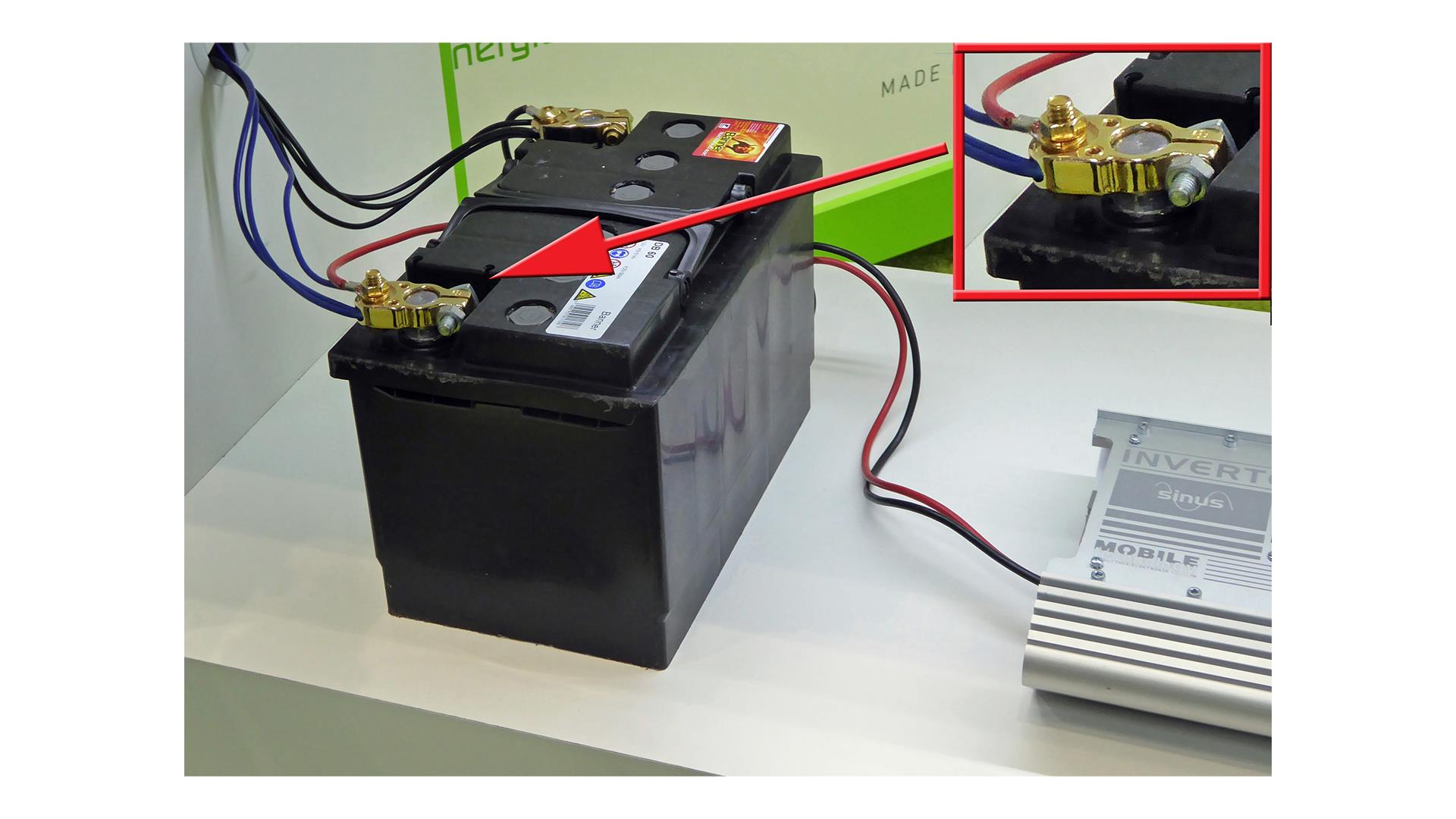
The best advice is to connect directly to the leisure battery via a fuse using clamp type terminals. It is also advisable to keep the DC wiring to the inverter as short as possible to minimise voltage drop, with the associated loss of power. Where long runs are unavoidable you need to compensate by increasing the size of the connecting cables. If in doubt seek professional advice.
The following table can be used as a guide when using single-core Polyvinyl Chloride (PVC) insulated cables.
Cable Sizing for Inverters

Reverse polarity
When connecting an inverter to a battery, be extremely careful to get the polarity right (positive to positive, negative to negative). If the inverter has reverse polarity protection the worst that should happen is that you will blow a fuse. If not, the inverter may be seriously damaged
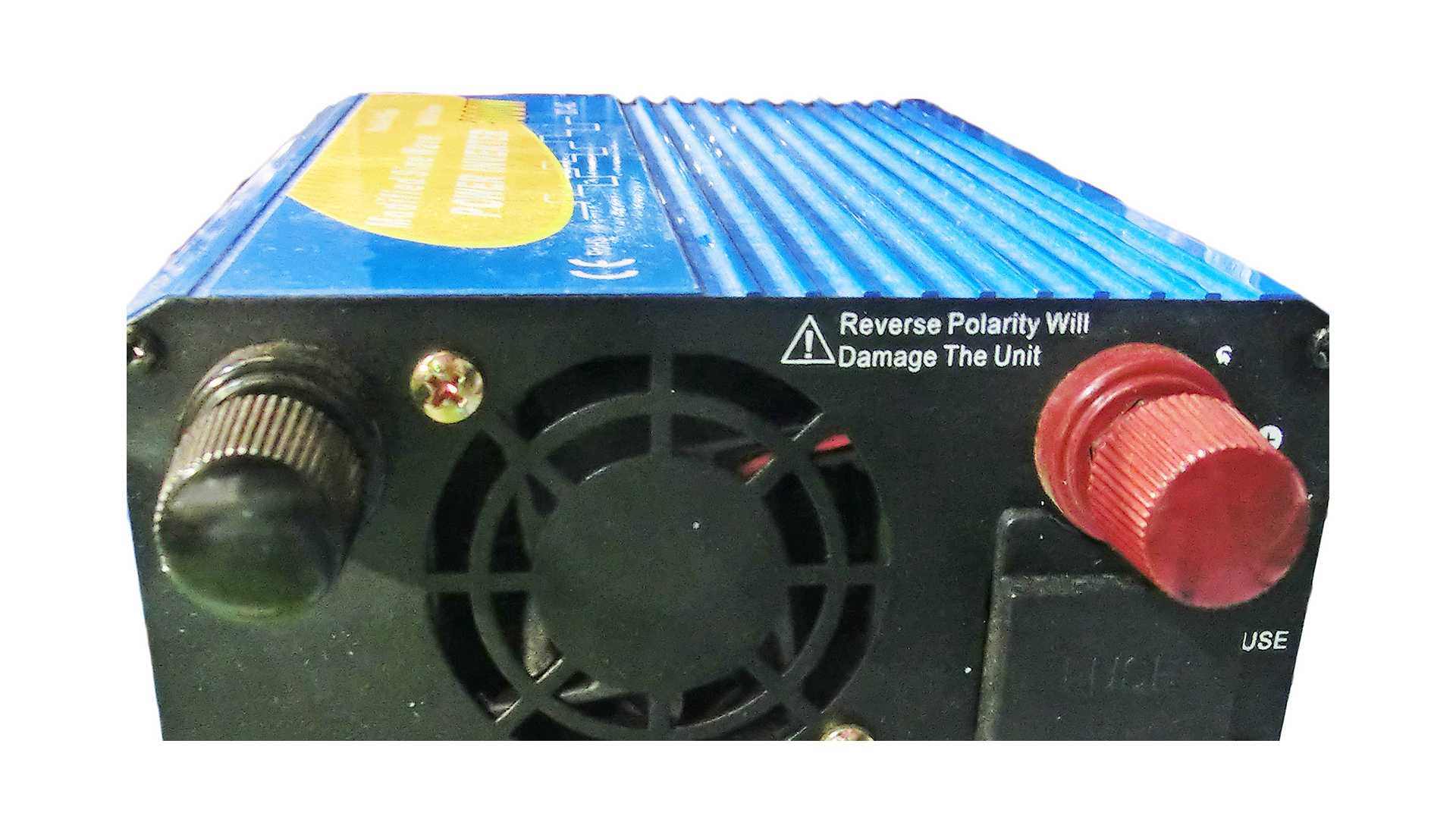
How long will my leisure battery last?
The following table is designed to give a rough guide of how long your lead acid leisure battery will last between charges. It assumes the battery is in good condition and not discharged below 50 per cent of capacity (to preserve its life). It also assumes the inverter is working at 90 per cent efficiency.
No allowance is made for the effects of Peukert’s law (see Useful formulas below). This means loadings below about 200W are likely to give slightly longer times than shown here, while loadings above will result in reduced times.
Inverter Usage Between Battery Charges
Useful Formulas
Although not strictly accurate in all circumstances the following should prove handy when dealing with inverters:
Watts = Amps x Volts
So, a coffee maker rated at 1,000W would consume 4.3A at 230V but 83.3A at 12V (83.3 x 12 = 1000). This latter calculation does not allow for losses within the inverter or wiring so the actual current needed would be nearer to 90A.
Peukert’s law and battery capacity
A lead acid battery rated at 100Ah is good for about 50Ah before it should be recharged. This is calculated over a discharge time of 20 hours. If you discharge it faster you will get less than 50Ah; if more slowly, you will get more. This is an effect known as Peukert’s law and is something to bear in mind when working out what you might be able to run using an inverter.
Starting power = 2 to 6 x running power
Depending on what is connected, the power required to start up may be up to six times the power required in normal running. This can mean choosing a much beefier inverter than you might think.
Known issues when camping
Here we detail some of the problems that camping and caravanning can cause inverters.
Inverters in cold weather
Bringing an inverter inside from the cold can result in condensation forming on all its surfaces, including the electronics inside. If this happens, let it warm up and dry out for an hour or so before being put to use. Failure to do so could result in malfunction or damage.
Powering sockets in your caravan or motorhome
It is generally not a good idea to connect an inverter to the power sockets in your caravan or motorhome, either directly or indirectly, via the hook-up cable. Modified sine wave inverters will almost certainly damage switch-mode chargers and indeed any sensitive item that might be plugged in somewhere.
Pure sine wave inverters should not cause damage but could easily become overloaded and you do not want them charging the leisure battery, especially if that is powering the inverter. Under no circumstances should the output of an inverter ever be connected to the mains supply. The inverter will be damaged and may even catch fire. If you do decide this is worth exploring discuss with a professional installer what is possible so the system can be safely designed.
Safety
230V electricity can be lethal, no matter whether from an inverter or mains supply. You should therefore take every precaution to avoid electric shock, especially in damp conditions. Also, when using a modified sine wave inverter, regularly check the equipment being supplied for any signs of overheating. If in doubt, switch off and consider professional advice on using a pure sine wave inverter.
Inverter type generators
Good quality portable generators may feature an in-built inverter. The reason is that inverters eliminate the need for the generator to run at a constant speed to maintain a steady output of 50Hz compared to a traditional generator that must run at high RPM to be able to provide this consistent output. At lower loads the speed of the inverter generator can be decreased so reducing both fuel consumption and noise.
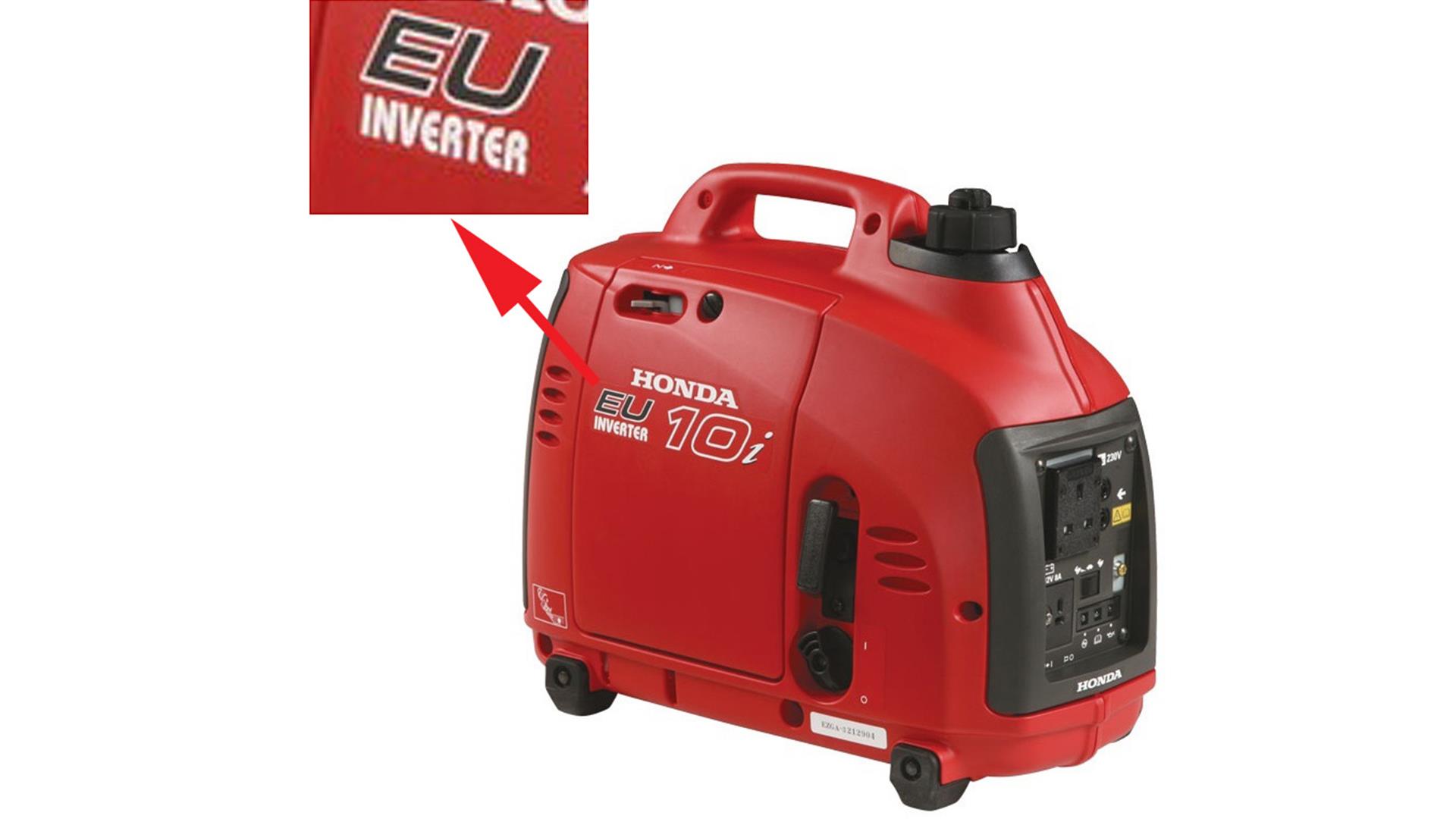
Instead of generating 230V AC directly, these generators provide 12V DC to feed an onboard inverter. The 12V is normally also available to charge a separate leisure battery when needed.
Of course, you still need to know whether the output of the inverter is a pure sine wave or not. If a pure sine wave is needed you could consider a generator without an inverter built-in. This will probably be cheaper although the frequency might not be as stable.
Power station with inverter
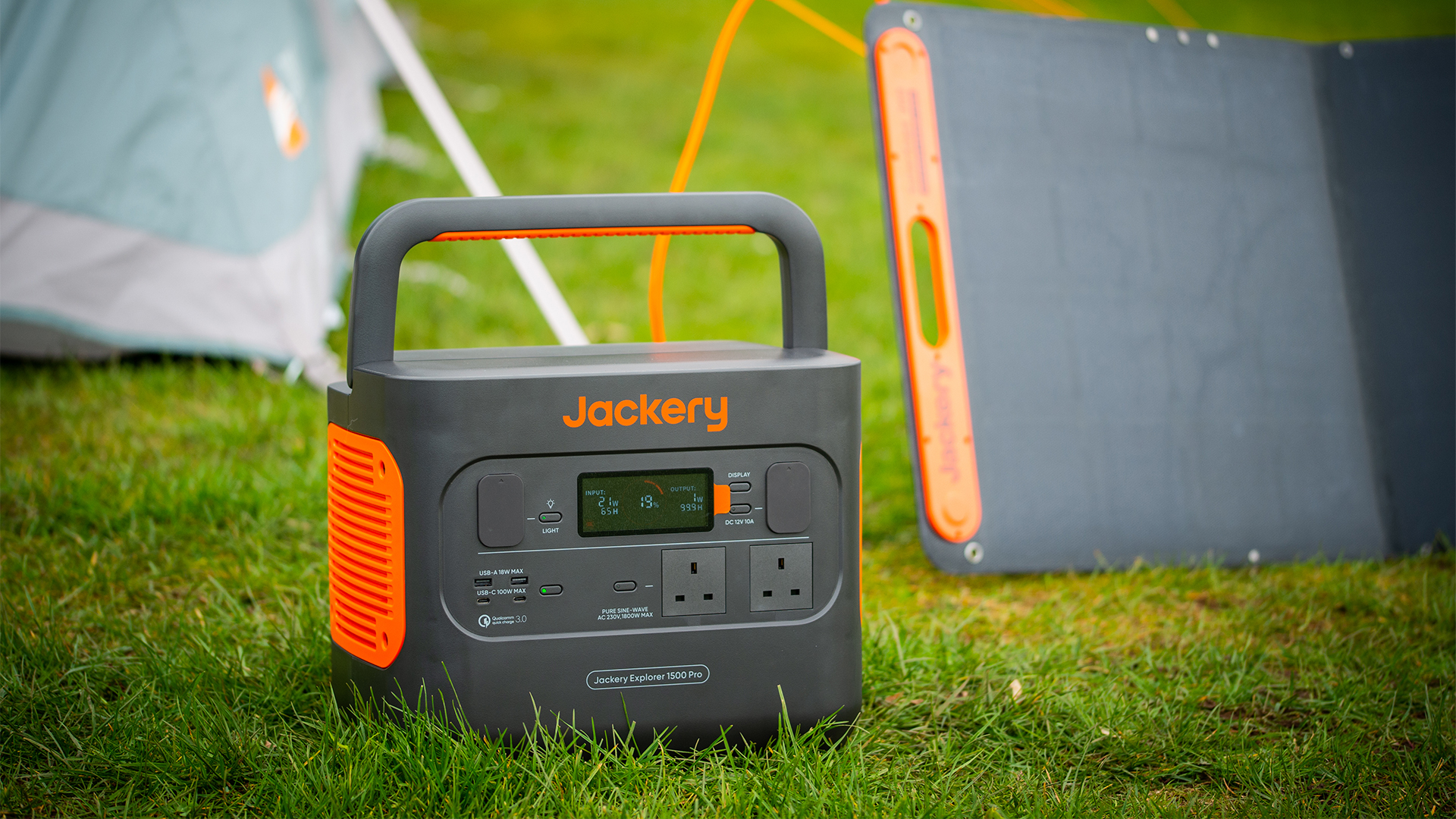
With the introduction of lithium batteries into the leisure sector it is common to see portable power stations on the camping field, not only do these give you and handy ready made way to connect all your 12v and USB devices they typically include a suitable sized inverter so for some this will be a more convenient choice as it can be used in many situations and be charged by solar, a 12v dc or 230v ac outlet. Sizing principals will be the same as previously explained.
Other useful sources of information
Expert guide on campsite electricity
Expert guide to leisure batteries
Expert guide to solar power and solar panels for camping and caravanning
Expert Guide to charging a leisure battery
There are a number of companies on the Club discount pages that offer discounts related to this subject for members.

